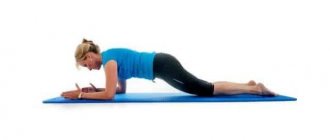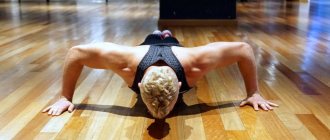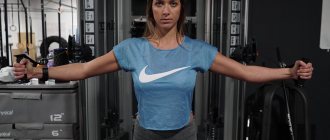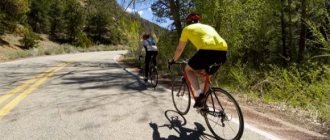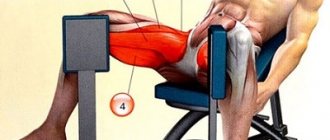Rules for training the pectoral muscles
Lower pectoral muscles
Before starting training, an athlete must learn some postulates of competent and effective exercises:
- You can’t use 1 or 2 exercises, you need to combine techniques to achieve comprehensive muscle development;
- training should begin with exercises designed for the lower chest - this way you can achieve a better effect, but if you train in the middle, you won’t be able to give it your all, since this gymnastics is labor-intensive;
- the load should be intense - this is the only way to achieve real muscle activity;
- on a training day after rest, it is necessary to train the lower pectoral muscles, since a rested body copes better with a heavy load;
- It is best to combine training of the lower pectoral muscles with the middle muscles of the chest.
The athlete should not forget that classes must be varied, adding new exercises to them from time to time. After an intense workout, you need to rest. It is not recommended to train the lower muscles on the same day as other types of physical activity.
Recommendations for pumping the lower pectoral muscles
- Training should consist of different types of loads. Take 1-2 basic exercises as a basis and add 2-3 isolating exercises to them.
- If you are a beginner, try to gain overall muscle volume first, and only then work on drawing the lower part of the pecs.
- To pump up the lower pectoral muscles, choose only those exercises in which the movement is performed in the direction of the “working” fibers.
- In each basic exercise, do 3-4 sets of 8-12 repetitions, in each isolation exercise - 3-4 sets of 12-15 repetitions.
- At the end of the session, do some light chest stretches. This will help you recover faster and give an impetus to fiber growth.
The best exercises in the gym
Dips
A bench is the simplest tool that can be used at home. The main requirement for it is the ability to adjust the angle of inclination. The most effective training methods on parallel bars and benches include:
- Dips. A very effective and useful exercise for the lower part of the pectoral muscles, which works even the deepest muscles. During the exercise, the elbows are placed as wide as possible, and the chin is pressed to the body, then the emphasis shifts to the chest, and not to the triceps. To gain muscle mass, do up to 8 repetitions in 4 sets. Over time, the number of repetitions can be increased.
- Reverse incline dumbbell bench press. The bench is installed so that the place where the legs lie is 30 degrees above the head. Doing this exercise is prohibited if there are problems with the blood vessels of the head or if blood pressure rises. Dumbbells in this case work better than barbells. During training, take a basic position and repeat 3-4 sets of 12 exercises. Your arms should be raised strictly above your head as you exhale.
- Reverse incline barbell press. Perform the same as the previous exercise. The apparatus should be held in a wide position to activate the lower chest muscles. The number of repetitions is reduced to 8 in 3-4 approaches.
- Reverse dumbbell raises. The exercise is performed on a bench. Before you start, you need to choose a comfortable weight. The arms are spread as wide as possible - they should be slightly below the back, not parallel to the floor. Slowly bring it back while inhaling. Repeat 9-12 times in 3-4 approaches.
Reverse Dumbbell Press
Reverse Bent Press
Reverse Dumbbell Flyes
The next exercise will require setting up the crossover. Bringing your arms together while standing helps separate the muscles. An exercise for the lower pectoral muscles is performed by crossing your arms downwards. Do several approaches 10-15 times. The main thing is to set the appropriate weight so as not to overstrain yourself.
Hummer Seated Press
Hummer press
The hummer is not the most popular exercise equipment, but it is very effective at working the lower chest muscles. The seated press using a hammer completely imitates working with free weights, but protects the trainee from its side effects - the risk of injury. If the exercise machine is present in the gym, you need to choose an option created specifically for the lower chest.
During the exercises, you need to lift the weight 8-12 times in 3-4 approaches. Before class, you must select the correct weight in consultation with your trainer.
We pump up the lower chest in the gym
We have the following exercises at our disposal:
- Bent-over dumbbell press (legs above head);
- Bent-over barbell press (legs above head);
- bringing your arms together in a crossover (arms below your chest);
- bars again.
Bent over dumbbell and barbell press
Let's be honest, the dumbbell press is performed exactly the same as the barbell press, so we'll look at both exercises here. We will need a wall bars and an inclined bench that can be mounted on this wall at any angle. We hang the bench 30 degrees down.
- We take dumbbells (we start with a warm-up) weighing 5 kg, leave them on the sides of the edge of the bottom of the bench.
- We lie down on the bench with our feet up (we attach them to special bolsters that should be on the bench). Now you are hanging upside down. Take dumbbells and place them in front of you so that there is a right angle between your hands and the floor.
- Unfold the dumbbells as if you were holding a barbell. Lower the weight onto your chest, spreading your elbows to the sides.
- We lift as we exhale. Don't hold your breath!
Then we take working weights and work out. If you find it difficult to lift the weight yourself, ask a trainer or partner. Usually you pick up one dumbbell yourself, and the second one is handed to you by your partner.
If you are working out with a barbell, your partner must remove and deliver the barbell. He also insures you during the exercise.
The lower your head, the more load the desired part of the chest receives. You can lower the bench either 45 degrees or 60.
Bringing hands together in crossover
We will deal with the upper blocks. We hang handles on the cables that are easy to grip with one hand. We warm up with 2–4 kg to understand the essence of the exercise and the technique of movements:
- We spread our arms to the sides and grab the handles with a direct grip, palms down. We slouch a little to tighten our pectoral muscles. At this moment, you look like an eagle during the landing, when it slows down with its wings (usually, such a comparison immediately clarifies all the points).
- We move one leg back for stability. We tilt the body forward and slightly down. The lower back is arched, the pelvis is laid back.
- We begin to bring our hands together, the crossing point will be at the level of the groin or lower. This position ensures pumping of the lower pectoral muscles.
- We do 10 repetitions. Then we hang the working weight and perform 3 sets of 10–12 repetitions.
Bars in the gym
If you do 15-20 push-ups, there is no point in working without weight:
- Ask the trainer on duty for a special weight belt.
- Do 15 push-ups as a warm-up.
- Do 5-8 push-ups without weight (if you have enough strength and can do many push-ups without weight, 10-15 times will do for a warm-up).
- We hang the pancake on our belt. We carry out the working approach using the technique described above.
Let's go as low as possible. For greater effectiveness, it is recommended to stretch on the parallel bars before doing push-ups. To do this, grab the handles in the same way as when doing the exercise, then gradually lower yourself down, supporting your body with your legs. This will allow you to go deeper during the push-ups themselves.
Exercises without machines
Pullover
You can also practice at home. It’s easy to pump up the lower pectoral muscles using available tools. You should get dumbbells of different weights, since without them it is extremely difficult to work the chest.
- Pullover. To perform this you will need a bench or stand to lean over. You need to lie across the bench and ask someone to hand you a dumbbell. Grasp it by the end with both hands so that the palms are directed upward. Now they lift the projectile above themselves, carefully and slowly straightening their arms. Exhale and lower the dumbbell behind your head again, drawing in air through your chest to the maximum so that you can feel your ribs and muscles expanding. At the bottom point, you need to hold your breath for a couple of seconds, and then smoothly return to the starting position, exhaling and maintaining tension in the elbows.
- Push-ups from the floor or books. One of the simplest, but very effective exercises for stretching and improving the pectoral muscles is push-ups. This exercise is very suitable for girls, as it is simple and does not require working with weights, which can cause injury. You can place your hands on a couple of stacks of books, rising above the floor at a distance of 20-30 cm. They should stand 15 cm from each other. Palms turn inward. Do push-ups slowly, bending down as low as possible. It is at the moment when the elbows go above the back that the muscles move apart and the pectoral muscles are developed.
- Doing push-ups from the bench. This is a lightweight version of the exercise, in which you need to lean against a sofa or bench so that your body takes an angle of 45 degrees relative to the floor. Do push-ups, touching the chest with the apparatus.
- Horizontal bar. You can install an iron horizontal bar at home - it is sold in sports stores, is inexpensive and can be easily attached to almost any wall. They stand with their back to the bar, grab it with a narrow grip, jump and fix the body on straight arms. There is no need to repeat it many times, as this exercise is quite difficult to perform.
Bench push-ups
Close grip pull-ups
Book push-ups
During training, you should not pump only the lower part of the pectoral muscles. We must not forget about the upper muscles, as well as other muscle groups.
Exercises for muscle development are combined: you can train 2-3 times a week, but the program should include at least 3 different variations of gymnastics. If an athlete trains in the gym, he can combine a bench, crossover and hammer.
Working out the lower chest at home
We will practice at home and in any yard where there are low horizontal bars and parallel bars. First, we'll tell you how to pump up your lower chest with push-ups. This is the most successful option, since it does not require a special body position in which your head is lower than your legs. Many people recommend special supports for push-ups - we agree with them, because the option with books is not the best idea.
Push-ups on books
This option is convenient because we can change the height of the stands. And it’s (very) inconvenient because books can fly out from under your hands. As a result, we fall face down on the floor. From the outside it’s funny, but from the first person it’s often painful. Let's get back to technology:
- We put a couple of books and rest our hands on them. The legs are straight and stand at a distance of 10–15 cm from each other. The palms are oriented with the fingers forward and inward. Hands shoulder width apart.
- We sink as low as possible (this is why we need books, so as not to rest our faces on the floor when we can sink even lower).
- At the lowest point, you can stop and freeze for 2-3 seconds for maximum load on the chest.
- We do 3-4 sets of 15 repetitions without weight and 6-8 repetitions with weights.
We do not recommend doing push-ups on books with weights - it will hurt to fall.
Why are books needed? It is necessary that at the final lower point above the body is higher than the legs. With this arrangement, the chest begins to be loaded from below.
Push-ups on special supports
This is done in exactly the same way as on books. The huge advantage is that you won't fall. The technique is the same.
Push-ups from a bench or cabinet
This is the best option to work the lower chest. It's both convenient and safe.
We rest our hands on the bench (fingers pointing inward and forward), legs slightly apart. We do push-ups until our torso touches the bench. Here you can also use a weight in the form of a backpack with weight.
Dips
Before parallel bars, we recommend warming up with push-ups from the floor – 10–15 times. It is recommended to do push-ups like this:
- Place your arms wide apart. If the bars are not sliding, then we place our elbows to the sides. We don't make any "boats" here. We slouch a little to round our back and begin an even up-and-down movement. There is no need to fully extend your elbows.
- We do 10-12 repetitions in 3 sets without weights or 6-8 repetitions with weight.
On the horizontal bar
A very interesting and complex exercise that helps in practicing the “exit with force on two arms” element. If you are good at pulling yourself up, you can do it on a regular horizontal bar. If not yet, it is better to choose a low horizontal bar so that it is at the level of your head:
- We grab the horizontal bar with a straight grip, hands at a distance of 20–25 cm from each other.
- We jump and stand on the horizontal bar with straight arms. The pelvis rests against the crossbar.
- We lean forward a little and begin to lower ourselves, spreading our elbows to the sides. We go down as low as possible, after which we return to the starting point.
- We repeat the exercise 6–8 times.
Before the exercise, it is recommended to do push-ups on the bench 10–15 times. Practice has shown that not every beginner can perform such an exercise. So try it.
Possible problems and errors
Inexperienced athletes constantly encounter incorrect technique and disrupt the rhythm of training. Knowing the most common mistakes will help prevent them:
- During the exercise, the triceps are involved, and the lower chest does not receive stress. You can correct the mistake if you contact a trainer; one consultation is enough to understand what exactly is going wrong and needs to be corrected.
- It is important to follow the technique 100%, not deviate from it, not make it easier or complicate it - over time, the athlete will learn to understand exactly where he makes mistakes, because recognizing when the lower chest muscle is working is not so difficult.
- Some athletes train forcefully if dangerous symptoms appear: dark vision, tinnitus, and increased blood pressure.
To rid yourself of unwanted symptoms and increased blood pressure, you should perform the following test: lie on a bench at an angle of 30 degrees, and after 1-2 minutes stand up sharply. If ripples appear in the eyes and noise in the ears, you should not train in this position.
Proper nutrition for chest muscle growth
An athlete who can organize proper nutrition during training can achieve real success. To do this, the following conditions must be met:
- eat protein every day - there should be more of it than in the diet of a person who does not exercise;
- Protein proportion – at least 50% of the athlete’s entire diet;
- carbohydrates in the form of cereals and fruits can only be eaten in the morning and at lunch; in the evening they turn into fat;
- for dinner you need to eat protein: fish, chicken, poultry with vegetable salad;
- before training, you can eat the right sugar: smoothies, bananas, other products with natural glucose;
- and after training you need to increase your protein intake by drinking a suitable protein shake;
- you need to eat fractionally so that the metabolic process does not stop for a minute - at least 5 times a day;
- portions should be small so as not to stretch the stomach, and it is also very important to drink clean water.
Nutritional supplements for bodybuilders can be used if you are unable to reach your protein requirements. Pure protein is an ideal alternative to meat, which contains hormones and unwanted fats. Soy and whey proteins work better than others. The instructions for all dry proteins tell you how and how much to use.
Wanting to pump up the lower part of the pectoral muscles, athletes often forget about other activities. You can achieve better results if you train your muscles in combination with cardio exercises, and also do not forget to pay attention to the upper group and other muscles. Following the techniques, regular exercise, and a suitable diet are a guarantee of success.

